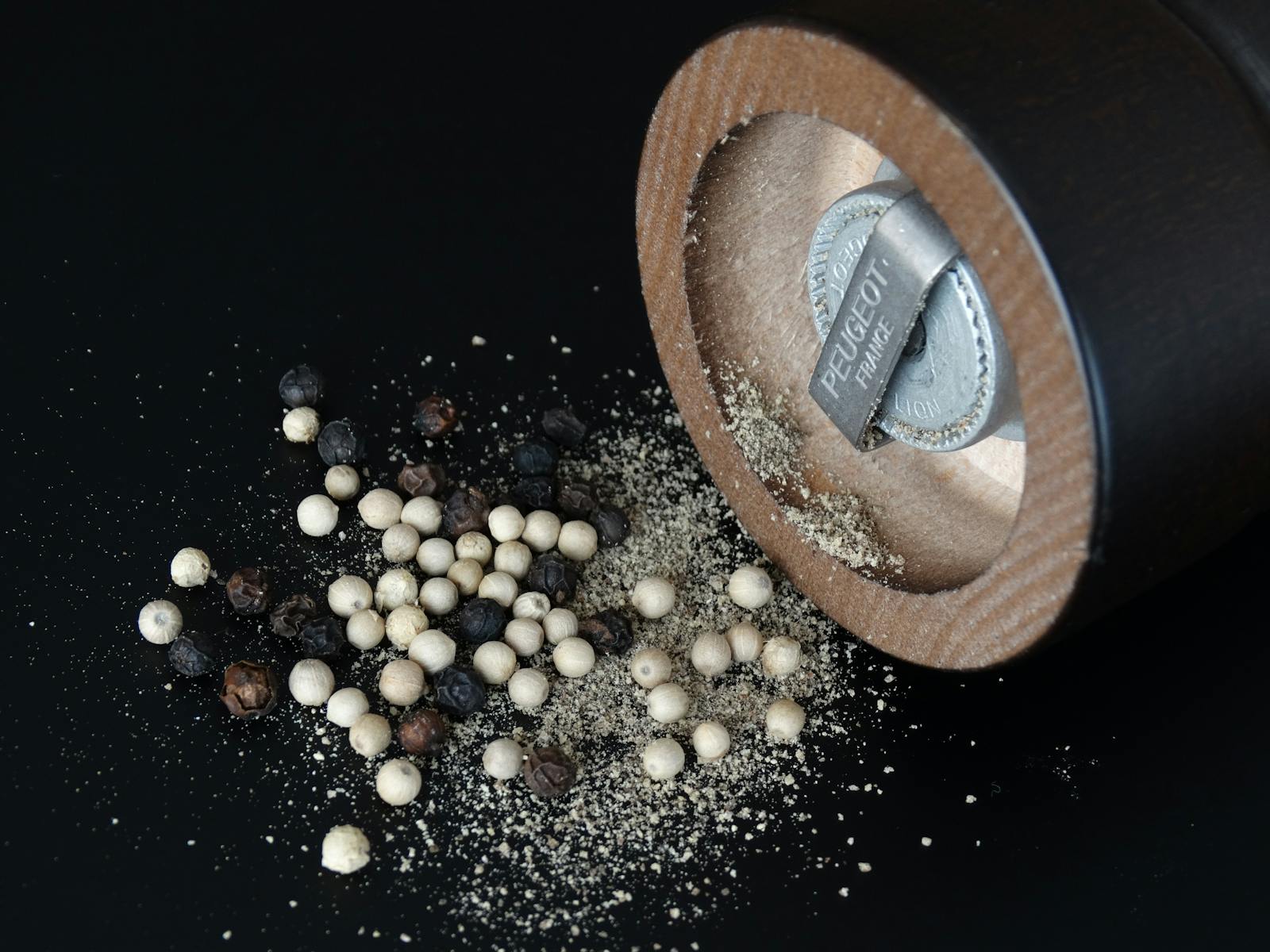Piperine, the active compound found in black pepper, has gained significant attention in recent years due to its ability to enhance the bioavailability of various nutrients. Bioavailability refers to how well our body can absorb and utilize the vitamins, minerals, and other nutrients we consume from food or supplements. Piperine has been shown to improve the absorption of several nutrients, including curcumin from turmeric, beta-carotene, and even certain drugs.
By incorporating piperine-rich foods into your diet, you can significantly improve your body’s ability to take full advantage of the nutrients in your meals. Below, we’ll explore 13 foods rich in piperine and explain how they work to enhance nutrient absorption, while also offering a variety of health benefits.
1. Black Pepper
It should come as no surprise that black pepper itself is the richest and most direct source of piperine. Black pepper is commonly used as a spice in countless cuisines and is easy to incorporate into almost any meal. A simple sprinkle of black pepper not only enhances the flavor of your food but also improves the absorption of essential nutrients, particularly fat-soluble vitamins and antioxidants.
In traditional medicine, black pepper has been valued for its digestive and anti-inflammatory properties. Piperine in black pepper can stimulate digestive enzymes in the pancreas, promoting better digestion and nutrient absorption. Additionally, research suggests that black pepper may enhance the bioavailability of curcumin, the active compound in turmeric, by up to 2000%. This makes the black pepper and turmeric combination a powerful health-boosting duo.
2. Turmeric
Turmeric is one of the most well-known superfoods due to its potent anti-inflammatory and antioxidant properties, largely attributed to curcumin, its active compound. However, curcumin on its own has poor bioavailability, meaning the body struggles to absorb it efficiently. The solution? Pair turmeric with black pepper. Piperine enhances the bioavailability of curcumin, allowing the body to absorb and utilize curcumin’s benefits far more effectively.
This combination has been used in Ayurvedic and traditional Chinese medicine for centuries to treat a range of health issues, from arthritis to digestive disorders. The next time you enjoy a turmeric latte, curry, or supplement, don’t forget to add a dash of black pepper to maximize its effects.
3. Cinnamon
Cinnamon is a popular spice packed with antioxidants and anti-inflammatory properties. Lesser known is the fact that it also contains piperine, making it another valuable spice for enhancing nutrient absorption. Cinnamon can improve digestion and help stabilize blood sugar levels, making it a great choice for individuals managing diabetes or insulin sensitivity.
The warming, sweet-spicy flavor of cinnamon makes it incredibly versatile in both sweet and savory dishes. Whether you’re adding it to your morning oatmeal, smoothie, or baking, this spice will not only enhance flavor but also boost nutrient uptake.
4. Ginger
Ginger is another spice widely recognized for its anti-inflammatory and digestive health benefits. Like black pepper, ginger contains bioactive compounds, including piperine, that enhance the body’s absorption of nutrients. Piperine in ginger has been shown to improve the absorption of several vitamins and minerals, particularly those that are often difficult for the body to process, such as iron and zinc.
Ginger is commonly used in teas, stir-fries, and sauces. Its ability to calm digestive issues while also supporting nutrient absorption makes it an ideal addition to meals, especially for those looking to improve gut health and reduce inflammation.
5. Cloves
Cloves are a spice rich in antioxidants, anti-inflammatory compounds, and yes, piperine. This unique spice is often used in baking and savory dishes, adding warmth and depth to the flavor profile of many foods. Cloves’ piperine content aids in the absorption of nutrients, helping the body take full advantage of the vitamins and minerals present in the foods you eat.
Cloves have also been used in traditional medicine for centuries to alleviate toothaches, improve digestive health, and reduce inflammation. They are an excellent spice for enhancing the health benefits of your meals, whether in a hot drink, sauce, or baked dish.
6. Basil
Basil is a fragrant herb that’s a staple in Mediterranean cuisine, and it contains piperine that can aid in nutrient absorption. This herb is rich in vitamins A, K, and C, as well as antioxidants that help fight free radicals in the body. Adding basil to your meals can improve the absorption of these vitamins and support overall immune health.
Basil is a versatile herb that works well in both hot and cold dishes, including salads, pastas, and soups. Incorporating fresh basil into your meals not only enhances flavor but also supports nutrient absorption and boosts health benefits.
7. Fennel
Fennel is a vegetable known for its licorice-like flavor and nutrient-dense profile. It contains piperine, which helps the body absorb the vitamins and minerals it contains, such as vitamin C, potassium, and fiber. Fennel also has digestive benefits, helping to reduce bloating and indigestion.
Roasting fennel or adding it to salads can improve not only the flavor of your meals but also the bioavailability of other nutrients, making it a great choice for individuals looking to optimize their diet.
8. Dill
Dill is a fragrant herb rich in piperine, known for its fresh, slightly tangy flavor. Dill is often used to flavor fish dishes, salads, and dressings, but it also offers nutrient absorption benefits. Piperine in dill enhances the uptake of vitamins such as vitamin A, calcium, and magnesium.
Using dill regularly in cooking, particularly in fish or vegetable-based dishes, can boost nutrient absorption and add a unique flavor profile to your meals.
9. Mustard Seeds
Mustard seeds are tiny but packed with piperine, making them an excellent addition to your diet for improved nutrient absorption. Mustard seeds are known for their bold flavor and are commonly used in Indian and Mediterranean cuisine. Their piperine content helps the body absorb nutrients like iron, calcium, and omega-3 fatty acids from the foods you consume alongside them.
Whether used in sauces, marinades, or roasted dishes, mustard seeds bring both flavor and health benefits to the table, improving how your body processes vital nutrients.
10. Cardamom
Cardamom is a spice often used in Indian, Middle Eastern, and Nordic cuisines. It has a distinctive flavor that’s sweet, spicy, and slightly citrusy. Cardamom contains piperine, which enhances the body’s ability to absorb nutrients from food, particularly fat-soluble vitamins like A, D, E, and K.
The anti-inflammatory and digestive benefits of cardamom, combined with its piperine content, make it a powerful spice for promoting health and optimizing nutrient intake. Try adding cardamom to your desserts, tea, or savory dishes to benefit from its wide range of health advantages.
11. Oregano
Oregano is a widely-used herb, particularly in Mediterranean and Italian dishes. It contains piperine, which helps enhance the absorption of nutrients such as vitamin K, iron, and manganese. Oregano is rich in antioxidants and offers antibacterial and anti-inflammatory properties, making it a health-boosting addition to your diet.
Sprinkling dried oregano on pizza, pasta, or roasted vegetables will not only elevate the flavor of the dish but also support nutrient absorption, ensuring your body maximizes the benefits of your meal.
12. Thyme
Thyme is another herb with high levels of piperine. Known for its earthy and slightly minty flavor, thyme is often used in stews, soups, and roasted dishes. It enhances the bioavailability of important nutrients, including vitamin C, iron, and magnesium, while also offering its own health benefits due to its high antioxidant content.
Incorporating thyme into meals can help improve the body’s absorption of vitamins and minerals, particularly when combined with other nutrient-dense foods.
13. Saffron
Saffron is a luxurious spice, known for its distinct aroma, vibrant color, and high cost. It contains piperine, which makes it useful for enhancing the bioavailability of nutrients in the foods you eat. Saffron is often used in rice dishes, stews, and desserts to add both flavor and health benefits. Piperine in saffron can also boost the absorption of antioxidants and anti-inflammatory compounds.
Saffron has been shown to offer potential benefits for mental health, including reducing symptoms of depression and anxiety, making it not only a culinary delight but also a powerful wellness ingredient.
Conclusion
Incorporating piperine-rich foods like black pepper, turmeric, cinnamon, and various herbs and spices into your diet can significantly improve the absorption of essential nutrients. Piperine enhances the bioavailability of vitamins, minerals, and other beneficial compounds, ensuring that your body can fully utilize the nutrients it receives. By pairing these piperine-rich foods with nutrient-dense meals, you can optimize your diet, improve digestion, and support overall health and well-being.




